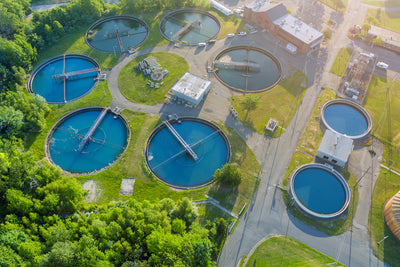Over 60% of Toxic Wastewater Biosolids Are Used To Fertilize Farmland in The U.S.
RSS
Analies Dyjak, M.A. | Head of Policy & Perspectives
Over 60% of leftover sewage waste or "biosolids" are used by farmers to fertilize crops in the U.S. A recent study found that a category of cancer-causing chemicals called PFAS were present in a majority of the fertilizing sludge - impacting food, livestock, and ultimately drinking water. Farmers expect that the biosolids coming from municipalities are entirely safe to use on their crops. Consumers also have this same expectation when buying produce at the grocery store. The reality is that municipalities don't even know the extent of what's hiding in sewage biosolids, but continue to encourage farmers to use it. Here's everything you need to know about biosolids and why farmers are still allowed to use it.
What Are Biosolids?
Biosolids is a universal term for solid waste or sludge derived from sewage treatment processes. Wastewater treatment plants first process the incoming contents by separating water from solid waste. Water is treated for biological contamination and sent back into nearby waterways where it becomes available for a variety of uses, including drinking water. What’s left behind is a sludge-mixture of human waste, industrial waste, and pollution from stormwater runoff. The leftover sludge or “biosolids” is much more difficult to treat, store, or dispose of. The nutrient-rich sludge becomes available for farms to purchase and use on croplands at a much cheaper rate than other types of manure. Surprisingly, the issue is not that human fecal matter is being used to fertilize crops across the country. The problem is that this sludge more often than not contains incredibly toxic chemicals that make their way into our food and drinking water.
Why Farms Use Sewage Waste on Crops:
EPA has documented that over 19 billion pounds of biosolid sludge has been used as fertilizer since 2016 in 41 states. The agency estimates that 60% of the nation's sludge is used to fertilize agricultural land, public parks, golf courses, and home gardens. Agricultural use of municipal biosolids has been around since the 1920’s - however environmental regulations didn’t kick in until 1993. There’s a strong case to be made that biosolids can be a cheap and effective way to fertilize crops - not to mention that farmers are able to reuse a naturally-occurring material to grow crops. Biosolids can also result in an increase in overall crop yield because of the addition of organic matter to soil. There’s a good chance that some of the food sitting in your refrigerator was grown using sewage biosolids.
Toxic Chemicals Are Present in Wastewater Sludge
PFAS or ‘forever chemicals’ are being detected everywhere - including in biosolids. Treatment plants aren’t required to test for or remove PFAS chemicals, so most of the time no one knows if they’re present. PFAS are found in industrial waste, drinking water, runoff from airports and military bases, as well as consumer goods. When these different types of waste are brought to a single area (i.e. a wastewater treatment plant), PFAS concentrations become alarmingly high. Because of the lack of testing and regulatory oversight, farmers are unknowingly re-distributing PFAS-containing toxic sludge into the environment while simultaneously contaminating their crops.
The EPA has detected 700 pollutants in sewage biosolids since testing began in 1993. In addition, the EPA has compiled of a list of 726 chemicals found in biosolids published in the National Sewage Sludge Surveys. However, the more than 9,000 different PFAS chemicals are not included in this list. Just because a pollutant is present does not mean that a wastewater treatment plant is required to remove it. Furthermore, EPA claims that “the presence of a pollutant in biosolids alone does not mean that the biosolids pose harm to human health and the environment.”
How Are Biosolids Regulated?
Biosolids, like other wastewater byproducts, are not particularly well-regulated. The “preparer,” which is often the public treatment plant, has to meet risk-based standards before providing the waste to the “appliers,” which are often farmers. It’s up to EPA to determine which pollutants in biosolids pose a risk to human health. EPA’s failure to regulate PFAS in biosolids and drinking water implies to the public that these chemicals are “safe,” even at concentrations that are known to cause cancer. EPA weighs the cost of removing a contaminant with the benefits to human health, resulting in safety limits that fail to do their jobs.
PFAS Levels at Organic Maine Farm Are 400 Times Higher Than State Guidelines
Farmers in Unity, Maine were some of the first to uncover PFAS pollution from biosolids on their land. A nearby town was home to a “molded fiber packaging” manufacturer in the 1990’s, which processed PFAS chemicals. The previous owners of the farm applied sewage biosolids to their land around the time that fiber manufacturing was in full swing. The current owners had no idea until they found a map of known sewage applications which revealed that their land had been contaminated. Testing found that PFAS levels in the farm's well water were 400 times higher than Maine’s state guidelines.
Similar stories are being told across the entire country - disrupting businesses, supply chains and public health; a Michigan cattle farmer was recently shut down after state officials detected PFAS in his water. The source was later traced back to fertilizer biosolids from a chrome-plate manufacturer in the area; Dairy farmers in both Maine and Wisconsin have dumped thousands of gallons of milk because of PFAS pollution in their cows; and companies in Ohio, the state with the most robust recordkeeping of biosolid use, have persistently violated EPA’s biosolid regulations.
Major Takeaways:
It’s now estimated that 20 million acres of U.S. cropland are contaminated with PFAS chemicals. EPA has yet to start navigating the culpability of PFAS producers, wastewater treatment plants, or municipalities in a meaningful way. We can expect to see “biosolids” to dominate headlines in coming months, but we could be decades away from meaningful action to protect public health. Our Water Nerds will continue to ask the question: who should be held accountable?
Other Articles We Think You Might Enjoy:Health Effects Caused by Exposure to PFAS Chemicals
95% of U.S. Tap Water Contains Microplastics
Things You Should Avoid Pouring Down The Drain:


